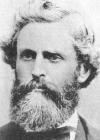1
The Early Years of Ranching in British ColumbiaThe ranching potential of the interior plateau of British Columbia was recognized in the early 1820s by the Hudson's Bay Company, which had exclusive trading rights in what was then known as New Caledonia. BC's interior, in the rain shadow of the Cascade Mountains, provided the perfect climate for bunchgrass, which turned out to be extremely nutritious for cattle and horses. The HBC needed horses to transport the furs it had obtained trading in the north, and decided to raise horses in the bunchgrass-rich areas around Fort Kamloops. In an effort to make the forts self-sufficient, the HBC introduced cattle to the Interior. Cattle drives from areas such as Oregon in the United States began in 1858, as the lure of gold drew hungry miners into this region. The real rush would begin in the following year with the discovery of gold in the Cariboo.
2
Cattle Drive from Quesnel into AshcroftCirca 1900
Ashcroft, British Columbia, Canada
 Credits:
Credits:Ashcroft Museum
3
In June of 1858, American General Joel Palmer drove a herd, following the Hudson's Bay trading route, from The Dalles on the Columbia River to the Thompson River Post (Fort Kamloops). Palmer paid 10% duty on the herd at Kamloops, a tax that was applied to all cross-border trading. This 'road tax' helped to build British Columbia's infrastructure, cementing British rule in the newly formed colony. In 1860, the Southern Boundary Act imposed higher duties, resulting in much unobserved border traffic until permanent crossings were established.During 1861-62, about 6,000 cattle were driven north from Oregon. By 1863, cattlemen were making a net profit of $40 each on cattle purchased at $10 a head. The industry then suffered a setback with the outbreak of the American Civil War and the imposition of an embargo, but soon thereafter, the importation of cattle reached a new peak of 3,429 in 1865.
Each year, the challenge for cattlemen was to get their cattle to the Cariboo mines by late spring in time for the mining season. In winter, the miners left the Cariboo and there was no market for meat during those months. As early as 1861, on the advice of Donald McLean, cattle were wintered in the hospitable climate and land of the Thompson, Bonaparte, and Hat Creek Valleys, in close proximity to the gold fields. On their arrival to this area, American cattlemen often sold their herds to local businessmen, who would then continue to drive to the Cariboo mines in the spring.


